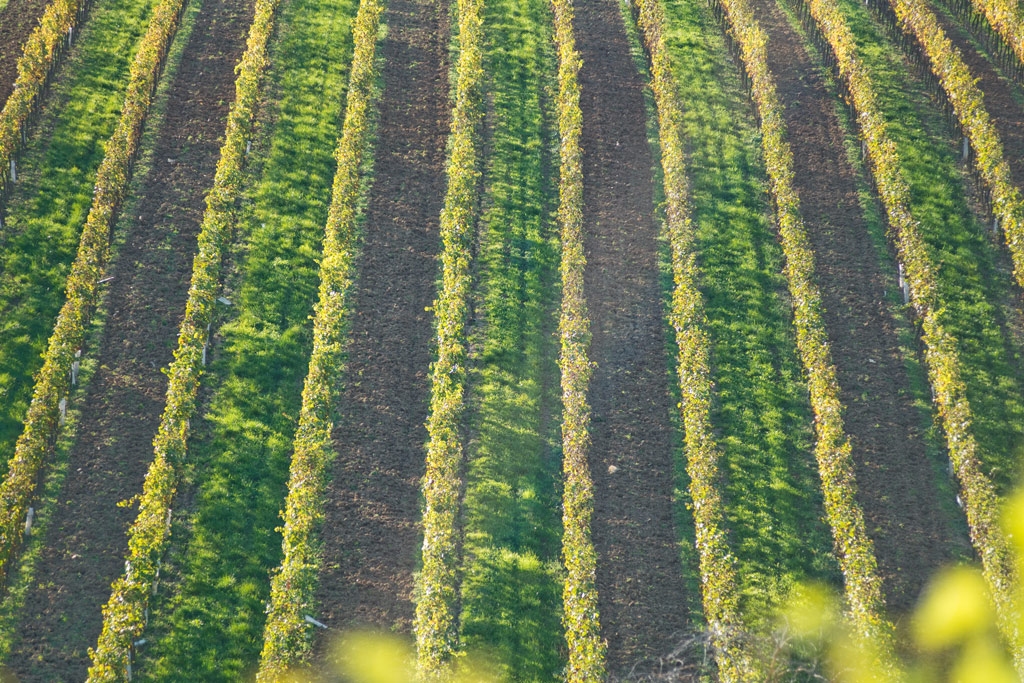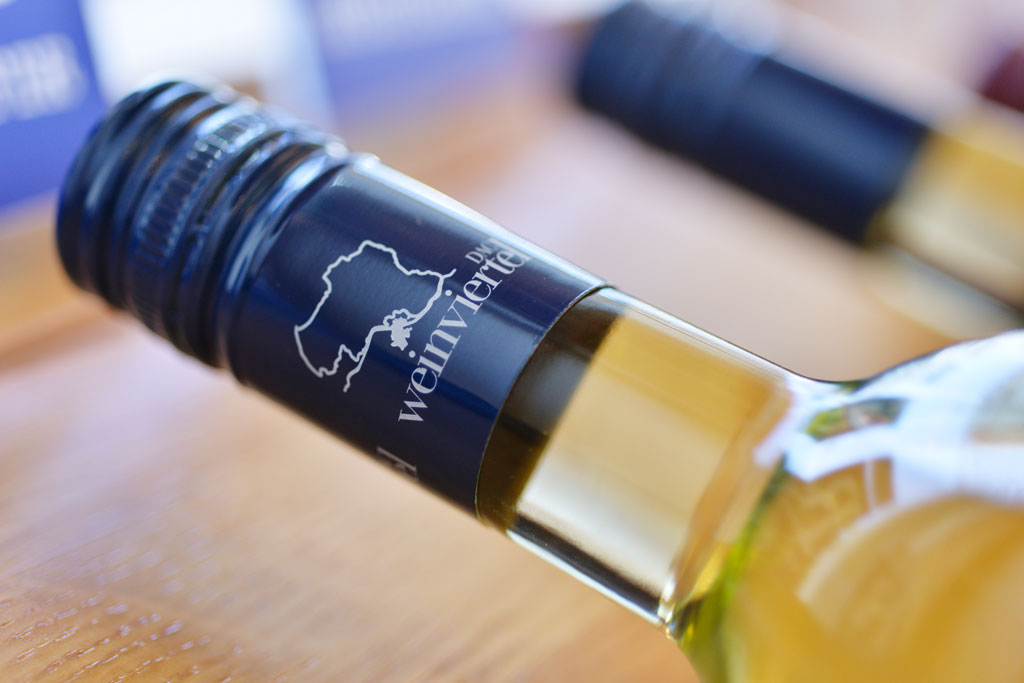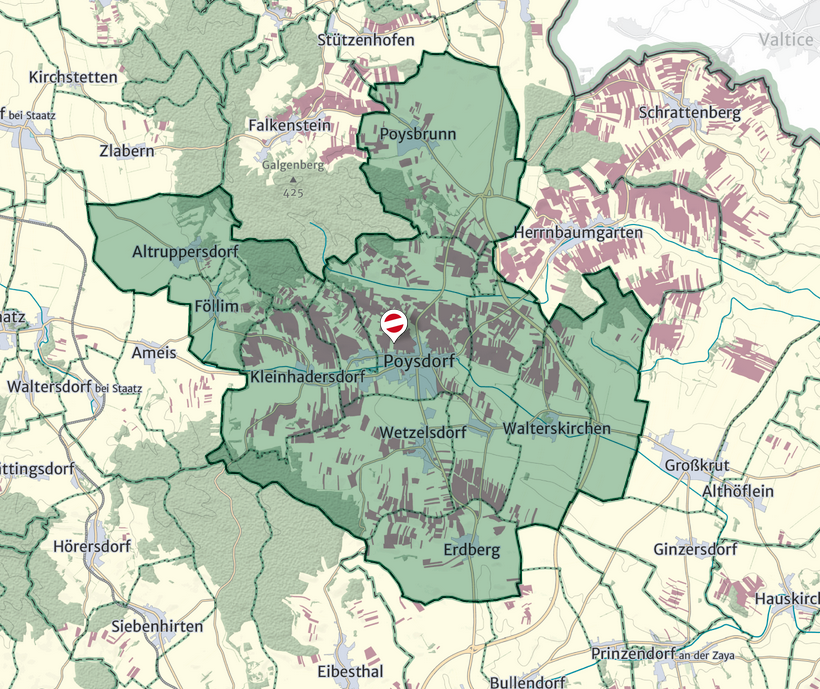Pearls of Weinviertel

Wine production in Poysdorf:
Permanent settlement around 7000 B.C. Evidence of agriculture and viticulture.
In 1338 the oldest vineyard in Poysdorf, the „Hermannschachern“, was mentioned in records.
During the 30 year war of 1618-1648 Poysdorf was invaded twice by troops.
On Palm Sunday in 1645 General Torstensson occupied Poysdorf with Swedish troops. Each man was given 5-7 litres of wine per day in order to quench the soldiers’ thirst. This made a total of 1000 buckets (1 bucket = 56 ltrs) – the so-called “Swedish drink”.
In 1667 the market community of Poysdorf received a coat of arms and a seal depicting two men carrying a large bunch of grapes which pointed to the importance of wine-growing in Poysdorf.
Today wine is produced on 1350 hectares in Poysdorf, a town with a population of approximately 5,500 (including cadastral communes). One third is planted to the key variety “Grüner Veltliner”, 10% is Welschriesling and a further 10% is planted to other white wine varieties. The most important red grape is Zweigelt.
The Weinviertel and the region around Poysdorf in particular has soil with a high loam and loess content, which, in combination with the special climatic conditions (warm to hot days and cool nights), allows the Grüner Veltliner grapes to develop the optimum level of acidity.
In Poysdorf there are 45 wine businesses run on a professional basis, making and selling excellent wines, many of which have won top awards. 30 of them are represented in the Wine Market. They open their cellars to the public once a year between Easter and All Saint’s Day.
The production of base wines for the renowned Austrian sparkling wine producers is an important part of the business for a number of the wineries in Poysdorf. Indeed, a large proportion of the base wines used for sparkling wine production in Austria comes from the area around Poysdorf.

Wine production and its development in general:
The first findings giving evidence to the history of wine production in Austria go back to approximately 700 B.C. In fact this is the oldest proof of wine making in the whole of central Europe.
Roman specialist literature about wine growing and vinification methods existed as early as the first century A.D.
In the Middle Ages it was the monasteries in particular which accelerated the development of wine making in Austria. They reclaimed land in the river valleys and constructed terraces in the Wachau.
In the 16th century vines were planted throughout the whole of Austria. The area under vine at the time was ten times larger than it is today thanks to the climate being more benign, lower quality aspirations and high demand due to historic developments.
In the 17th century there was a downturn in wine’s fortunes due to the Thirty Years war, the second siege of the Turks in Vienna, high taxes, competition from beer and also climate change. It was not until the time of Maria Theresia that wine production in Austria recovered from these devastating setbacks.
Disaster struck in 1850 when powdery mildew infiltrated Austrian vineyards, followed by phylloxera in 1872 and downy mildew in 1878. It was phylloxera in particular which destroyed just about all wine production, not just in Austria but actually in the whole of Europe. Everything had to start from scratch again.
The wine scandal in 1975 led to a generation change in Austrian wine production. Young well-educated wine growers took over their father’s estates. They turned their work into a profession, concentrated on the vineyards which had previously often just been of secondary concern, compared themselves with the best in the world and, most importantly, they realised one thing: their only chance was quality.
In fact it was the new Austrian wine law which allowed wine growers to free themselves of the consequences of the wine scandal from 1985 onwards.
The wine law governs the complete control of all wine stocks in Austrian cellars so that fraud is nigh on impossible; it regulates quality levels from table wine through to country and quality wine up to the level of predicate wines; it identifies the wine-growing regions and permitted grape varieties and it restricts the maximum yields per hectare more stringently than virtually any other European country. For example, if an Austrian grower wants to sell his wine as a quality wine, he is not allowed to produce more than 6750 litres of wine per hectare of vineyard. Moreover, every Austrian quality wine and wine with predicate is tested twice according to government regulations: via chemical analysis as well as tasting panel (a panel which cannot be bribed). Only wines which have passed both tests receive the state test number, which can be seen on the label along with the red-white-red banderole.
Sie sehen gerade einen Platzhalterinhalt von Facebook. Um auf den eigentlichen Inhalt zuzugreifen, klicken Sie auf die Schaltfläche unten. Bitte beachten Sie, dass dabei Daten an Drittanbieter weitergegeben werden.
Mehr InformationenSie sehen gerade einen Platzhalterinhalt von Instagram. Um auf den eigentlichen Inhalt zuzugreifen, klicken Sie auf die Schaltfläche unten. Bitte beachten Sie, dass dabei Daten an Drittanbieter weitergegeben werden.
Mehr Informationen






